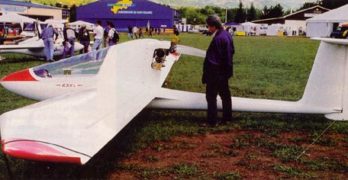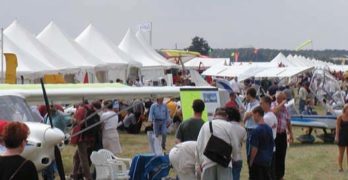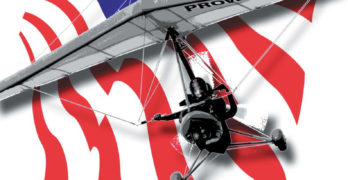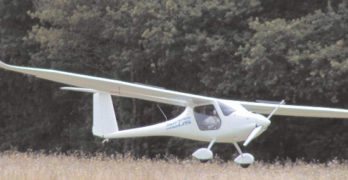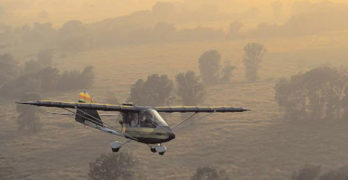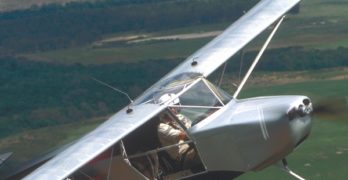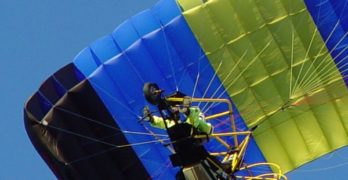ST. PAUL, MINN. — Have you been noticing the change to your magazine? Some pilots have had loud discussions about those changes yet many members have said little (as is common). You’ve been seeing the work of new art directors after a hard push by leaders to spark the magazine’s look and feel. Other major changes are ahead (more next month!) lll Are you ready for the combined magazine? Every other country I can think of has, for a long time, integrated their magazines for hang gliding and paragliding. The USHGA board of directors has worried through this decision with great care (I’ve a had a front row seat). It won’t please everyone; no decision ever does. But it will be the future. s The good news is, art directors Aaron Swepston and Tim Meehan have given each magazines a snazzier look. Most members to whom I’ve spoken seem enthused about the changes.
Search Results for : evolution
Not finding exactly what you expected? Try our advanced search option.
Select a manufacturer to go straight to all our content about that manufacturer.
Select an aircraft model to go straight to all our content about that model.
Product Lines – July 00
ST. PAUL, MINN., — The East rises again! Two spectacular flights within days of one another put a focus on the eastern half of the U.S. Internet author Davis Straub writes, "I was able to stay long enough in the air to break the current east coast hang gliding record by 20 miles. I flew my ATOS 212 miles from Wallaby Ranch to northwest of Valdosta, Georgia in about seven and half hours. This breaks the previous record set by Mark Poustinchian of 192 miles. It does not eclipse Pete Lehmann’s flex wing hang gliding record of 182 miles set in 1997 at Templeton, PA." So the $1,000 prize offered some years ago by Wallaby boss Malcolm Jones has been claimed. He put up the purse for anyone who could fly from the Ranch to the Georgia border. Reportedly, Jones is contemplating another XC prize to spur further achievement. ••• Shortly after this excellent accomplishment Aeros distributor GW Meadows wrote (with understandable pride), "Larry Bunner flew 213 miles from Leland, Illinois on a three-year-old Stealth 1.
Flightstar Inc. — Flightstar II + HKS Engine
Daring to take on deeply entrenched Rotax, Flightstar/H-Power has introduced the first light aviation four-stroke engine to see broad acceptance. Joined with their smoothly contoured Flightstar II, you can have a deluxe ultralight or lightplane that will provide years of flying enjoyment.
While two strokes do the job for most ultralight enthusiasts, the four stroke 700E engine from HKS of Japan offer assurances some pilots demand. With its particular strength of mid-range torque, the HKS engine brings interesting differences. Pull up the nose while revolutions are set in the 4000s and the HKS will haul the Flightstar II aloft with no evidence of prop loading common among two stroke engines.
Flightstar still sells lots of their very popular IISL models, but on this lighter aircraft, they recommend the Rotax 503. However, now that the same company has adapted the stronger HKS engine, sales are soaring for their Flightstar II with its beautifully formed all-fiberglass cockpit enclosure.
Ultralight Motorgliders
The ultralight motorglider evolution continues in Europe.
Ultralight motorgliders are as rare as hen’s teeth in the U.S., but Europe is blessed with several choices that nicely complement high-end, high-priced full-size motorgliders. While America has the lovely Esprit from Aero Dovron, our soaring friends across the Atlantic continue to lead this specialized market.
Full-size (higher-weight) motorgliders start at more than $100,000 and can surpass $200,000. Those who can afford them are surely thrilled with such beautiful machines, but most of us can’t spend that kind of money regardless of their superb performance.
However, at $20-$30,000 ready-to-fly, a clean self-launching soaring aircraft is more affordable. Like their larger siblings, these efficient designs can also cruise under power respectably well, giving them broader appeal than pure gliders.
Noins’ Excel
One of the newest of the breed is the Excel from France’s Noins Aeronautiques Alpaero. Based in beautiful Tallard in the French Alps, Noins is revered by French soaring pilots.
Blois Airshow
This French light-airplane show Tops Anything in the U.S.
The name of the French venue is a bit awkward for Americans, though it rolls off the French tongue fluidly. Blois—pronounced Blwah—is a superb airshow that should grab the interest of every light-airplane enthusiast.
Light Airplanes Everywhere!
I’ve been to Sun ’n Fun for more than 25 years and to Oshkosh nearly as many. I spend a lot of time in the ultralight area of each, and they’re big events, no question. But both take a second seat to Blois. Yes, believe it or not, the event 185 kilometers south of Paris last August is the largest of the ultralight airshows I’ve seen.
With 90 exhibitors and more than 500 aircraft, most of which were flown to the event, Blois beats even Paradise City at the Lakeland, Florida, Sun ’n Fun fly-in. I’ve known of this 22-year-old show since the ’80s but attended for the first time last summer.
American Trikes
Made in the USA and Yankee friendly!
Many pilots and even some experts believe trikes are a European innovation. Indeed, producers across the Atlantic took the breed to new heights, yet the fact remains that the earliest commercial producers of weight-shift trikes were here in the United States. In the early 1980s trikes were primarily an American phenomenon.
In the early days, before ultralights
had been defined, hang gliders
added power and slowly evolved to
use wheeled carriages. The first
producers included brands that
transitioned from the hang gliding
world, such as Soarmaster, Bennett
Delta Wings, and Flight Designs (no
relation to the German producer of
the CT). All of these American names,
and a good many more, are now
gone.
Today, when you hear the word
trikes, you may think of Air Creation,
Cosmos, Pegasus, AirBorne, or other
companies from Great Britain,
Europe, or Australia. Most of the
development work in trikes has
seemed to come from imported
brands.
Europe Embraces Light-Sport Aircraft
Many excellent aircraft may be headed our way
Parlez-vous Française? Sprechen Sie Deutsche? Parlate Italiano? Fortunately, to understand European recreational aircraft you don’t need to speak French, German, or Italian. Yet the light-sport aircraft (LSA) that may interest you could come from countries where the mother tongue isn’t English.
Welcome to the globalized
world of light-sport
aircraft where the workers
who built your plane may speak
Polish, Russian, Hungarian, or
Latvian in addition to French,
German, or Italian.
Though many intriguing
ultralights come from Europe and
Americans have seen a few of these,
many are a complete surprise to
Yankee pilots. That will change.
Last year after EAA AirVenture
Oshkosh 2002 ended, I traveled to
Blois (pronounced Blwah), France, a
town about 200 kilometers south of
Paris. There I attended the 22nd
salon (or air show) that organizers
present at this location each year in
late summer. Let’s take a walk
around the salon at Blois.
Hawks and their History
A look at CGS Aviation and its Roots
The Hawk and Chuck. Chuck
and the CGS Hawk. They are
absolutely intertwined. While
Chuck has a wife, Pixie (aka Nancy),
and family—four sons (Chuck Jr.,
David, Ted, and Don)—he has
another family in his aircraft.
Going Way Back
Our story this month takes us back
in time. EAA recently celebrated the
induction of Michael Sacrey into the
Ultralight Hall of Fame. He was
present near the beginning of the
movement. But even before
ultralights were officially recognized
as a segment of aviation, Chuck was
doing essentially what he is doing
today—selling flying machines.
In the early days, Chuck built
hang gliders, with names like the
Swooper, Spitfire, and Falcon (models
I through VII). While hang gliding
was most popular on the West Coast
and many major hang glider
manufacturers were located there,
hang gliding was also popular along
the dunes of the Great Lakes, and
Chuck’s operation was one of the
biggest in the eastern part of the
country.
An Escapade Just for You
Engineering design is usually an evolutionary process. While occasionally a breakthrough idea comes to market, most development in aviation is a result of small steps. The Escapade is a good example.
Once Flying K Enterprises (now Sky Raider LLC) offered their Sky Raider. The single-seater had much in common with the immensely popular SkyStar Aircraft Kitfox. In fact, when SkyStar offered their Kitfox Lite single-seater, Flying K built the welded fuselage for them.
Then came the Sky Raider II with a tight back seat that could be used for an occasional ride though not instruction as no controls were installed in the rear. The new Summit offered by Just Aircraft late last year was a variation on the Sky Raider II theme.
Company leadership changes as do their designs and the path from Flying K to Just Aircraft is convoluted; other business names are involved. By example, Rocky Mountain Wings, run by former Flying K partner Stace Schrader, offers their very similar Ridge Runner.
Gemini Powered Parachutes Come From Experience
According to the new Ultralight Flying! “Ultralight and Microlight Buyer’s Guide,” 24 companies are building powered parachutes in 2003. That figure doesn’t include recently announced foreign competitors and doesn’t count all that may follow. How does a new company stand out in such a crowd?
Gemini Industries boss Randy Snead is a well-known personality among powered parachute enthusiasts. He was the main technical person with Buckeye Industries, working with FAA personnel for months in pursuit of Primary Category certification. In blazing that new trail, Snead earned a reputation as being serious and knowledgeable.
His business enterprise is new to the scene, but given Snead’s long experience in this segment of light aviation, Gemini Industries should prosper. I see the company surviving any industry shakeout as the Indiana company keeps its overhead low and offers reliable products at low prices with reasonable delivery times. Gemini Industries isn’t flamboyant like some powered parachute producers and that’s exactly why Gemini’s formula should work.



